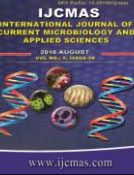


 National Academy of Agricultural Sciences (NAAS)
National Academy of Agricultural Sciences (NAAS)

|
PRINT ISSN : 2319-7692
Online ISSN : 2319-7706 Issues : 12 per year Publisher : Excellent Publishers Email : editorijcmas@gmail.com / submit@ijcmas.com Editor-in-chief: Dr.M.Prakash Index Copernicus ICV 2018: 95.39 NAAS RATING 2020: 5.38 |
Dermatophytosis, affecting skin, nails, and hair, is the commonestclinical condition encountered in the dermatology clinics in the tropical countries. Laboratories plays an important role in confirming the diagnosis when the clinical picture is not very clear. Good practical knowledge of fungal culture techniques and identification methods are crucial for better isolation ratesand accuracy of diagnosis. The present study involved60 patients with suspected dermatophyte infection attending Dermatology, Venereology and Leprosy clinic in Malla Reddy Narayana Multispecialty hospital, Suraram, Hyderabad.Fungal elements were seen in 20 cases by direct potassium hydroxide (KOH) mount examination and dermatophytes grew in 17out of these 20cases. The overall positivity rate was 33%. The predominant infectionobserved in this study was tinea corporis and the predominant fungus isolated was Trichophyton rubrum. Among the dermatophytes, Trichophyton rubrum grew rapidly ( ≤ 20 days), the earliest being within in 7 days. Microsporum species were comparatively slow growing, all three isolates grew after 20 days. In spite of being a very common condition in our country not much has been done about control of this disease. Most laboratories don’t isolate or have sufficient clinical data on susceptibility pattern of these fungal infections.
 |
 |
 |
 |
 |